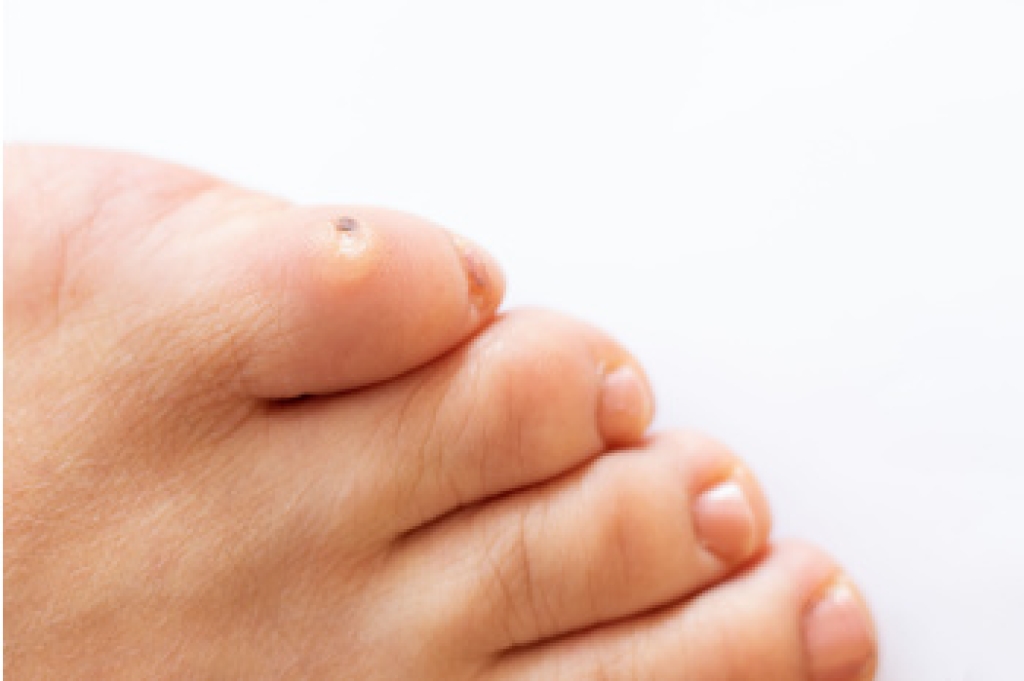Stages and Symptoms of an Ingrown Toenail

Ingrown toenails occur when the edge of a toenail grows into the surrounding skin, causing pain and inflammation. In stage one, the toe is swollen and tender with mild pain. Stage two involves increased pain, redness, and possible infection with pus. In stage three, the inflammation is severe, and there is significant infection and overgrowth of skin tissue. Symptoms progress from discomfort and redness to intense pain and oozing fluid. Preventing ingrown toenails involves proper nail care, consisting of trimming toenails straight across without rounding the corners, avoiding cutting them too short, and wearing shoes that fit well to reduce pressure on the toes. Maintaining good foot hygiene and regularly inspecting the feet can also help prevent the development of ingrown toenails and the complications associated with them. If you have developed an ingrown toenail, there may be significant pain, and it is suggested that you consult a chiropodist who can effectively treat this condition.
Ingrown toenails may require medical attention. If you have significant pain or notice signs of infection from an ingrown toenail, please consult with one of the chiropodists from The Footcare Centre. Our chiropodists will assess your condition and provide you with quality foot and ankle treatment.
What Is an Ingrown Toenail?
An ingrown toenail occurs when the edges of a toenail grow into the surrounding skin. The toenails of the big toe are usually affected, however, an ingrown toenail can happen on any toe. Sometimes, the area can become infected leading to potentially serious complications. The ingrown toenail may be caused by improper trimming of the toenail, wearing ill-fitting shoes, or injury to the nail.
Symptoms
The symptoms of an ingrown toenail include:
- Pain
- Swelling
- Redness
- Warmth
- Pus or drainage from the affected nail or a fever may indicate an infection of the area.
Treatment
Treatment depends on the severity of the ingrown toenail. In less severe cases, home treatment may be adequate. Soaking the affected foot in warm water and gently lifting the nail from the skin with a piece of clean cotton can help. In more severe cases, you may need to use topical or oral antibiotics to treat an infection. Surgical removal of the ingrown toenail may be required if more conservative treatments fail.
Ingrown toenails may be prevented by wearing well-fitted shoes and properly trimming the toenails. Toenails should be trimmed straight across and not too short when using nail clippers.
If you have any questions, please feel free to contact our office located in . We offer the newest diagnostic and treatment technologies for all your foot care needs.
Achieving the Perfect Running Foot Strike

The proper running foot strike is a critical element in enhancing performance and preventing injury. It refers to the part of the foot that first makes contact with the ground during a stride. There are three main types of foot strikes, which are heel, midfoot, and forefoot. Experts often recommend a midfoot or forefoot strike for most runners as these methods can promote a more natural running form, reduce the impact on joints, and improve overall efficiency. To achieve this, runners should focus on landing softly with their foot directly beneath their hips, rather than in front of the body. This technique helps in maintaining proper alignment and balance. A slight forward lean from the ankles, not the waist, can also aid in promoting a more efficient foot strike. Additionally, increasing cadence, or the number of steps taken per minute, can help in adopting a lighter and more responsive foot strike. If you have endured a foot injury due incorrect running form, it is suggested that you visit a chiropodist who can offer you relief methods, in addition to guiding you toward the correct running form.
The biomechanics of your feet play an important role in your foot health. To learn more, please consult with one of the chiropodists from The Footcare Centre. Our chiropodists can help you maintain the health of your lower limbs and your mobility.
Foot biomechanics refers to the study of the structure, function, and motion of the feet. The feet and ankles are a complex system consisting of many bones, joints, ligaments, muscles, and tendons that work together to move your feet. Understanding the unique biomechanics of your own feet can help you and your chiropodist make informed decisions about your foot health care. This includes decisions about the best preventive measures to avoid foot pain, the best treatment options for various foot problems, and finding the best shoes for your feet.
If you have any questions, please feel free to contact our office located in . We offer the newest diagnostic and treatment technologies for all your foot care needs.
Treatment Options for Corns on the Feet

Corns are painful, thickened areas of skin that commonly form on the small toes due to increased pressure from bony prominences. This pressure causes the skin to harden and thicken, resulting in discomfort, especially while walking. Non-operative treatment options for corns include padded corn sleeves, which distribute pressure more evenly, and toe spacers, which reduce friction between the toes. Corn donuts are another useful tool, off-loading pressure from the central painful area to the surrounding skin. Regularly trimming the callus can also help, though it is best to be done by a chiropodist, as the corn often recurs if the underlying issue is not addressed. In some cases, an X-ray may be necessary to identify the bony prominence causing the corn. Surgery is rarely needed, but can be considered if conservative treatments fail. Surgical options focus on removing the bony prominence and possibly straightening the affected toe joint. If you have painful corns, it is suggested that you schedule an appointment with a chiropodist who can determine what the best course of treatment is for you.
Corns are small bumps or dry, hardened skin that can arise on the feet, usually in response to friction. Corns can be asymptomatic, or they can be uncomfortable or painful. If you have corns that are bothering you, please consult with one of the chiropodists from The Footcare Centre. Our chiropodists can help you maintain the health of your lower limbs and your mobility.
There are three types of corns:
- Hard corns
- Often occur on the tops of toes
- Feature a hard core surrounded by dry, irritated skin
- Can be painful
- Soft corns
- Often occur in between the toes
- Soft due to constant exposure to sweat
- Can be painful
- Seed corns
- Tiny
- Often occur on the soles of the feet
- Usually asymptomatic
Corns can be prevented by wearing shoes that fit properly. They are typically benign and don’t require medical treatment. However, if your corns are causing you pain or discomfort, don’t hesitate to reach out to a chiropodist near you for treatment options. If you have any questions, please feel free to contact our office located in . We offer the newest diagnostic and treatment technologies for all your foot care needs.


